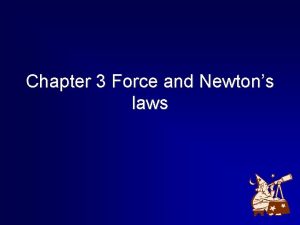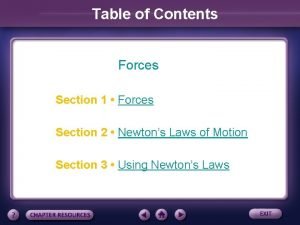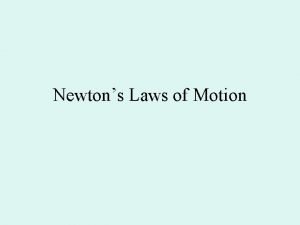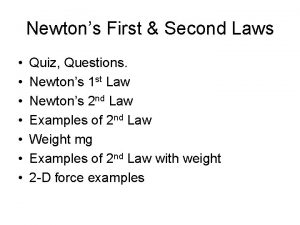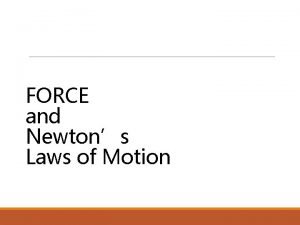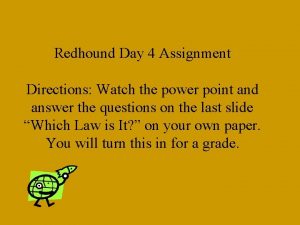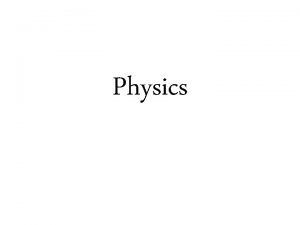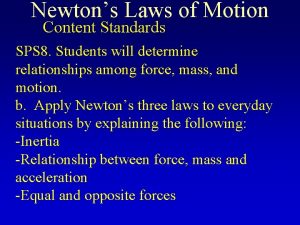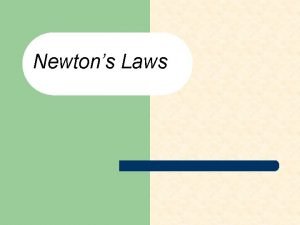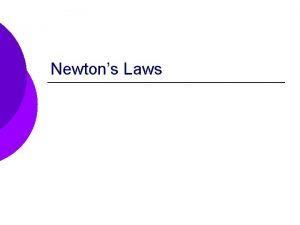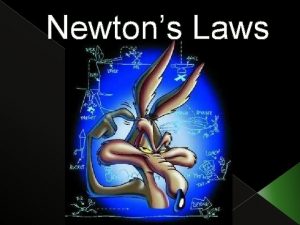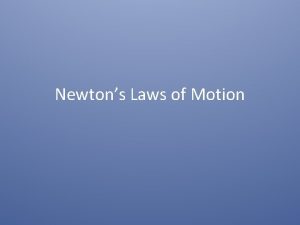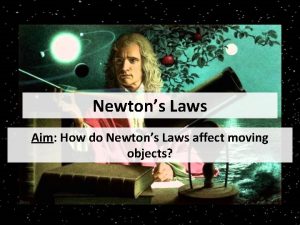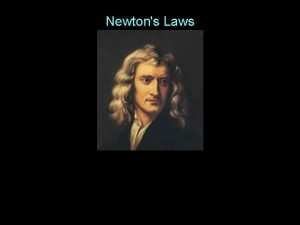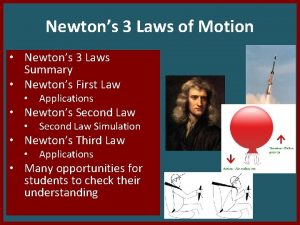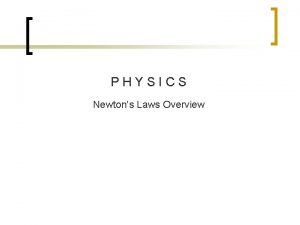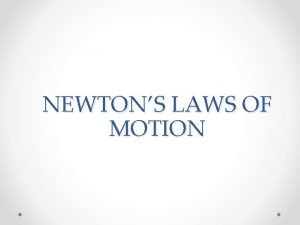More on Newtons 3 rd Law Newtons Laws

![Newton’s Laws Recap (I) First Law of Motion [Law of Inertia] An object at Newton’s Laws Recap (I) First Law of Motion [Law of Inertia] An object at](https://slidetodoc.com/presentation_image_h/1561fef1bb72960c80733289890adf0a/image-2.jpg)
![Newton’s Laws Recap (II) Second Law of Motion [F = ma] The acceleration of Newton’s Laws Recap (II) Second Law of Motion [F = ma] The acceleration of](https://slidetodoc.com/presentation_image_h/1561fef1bb72960c80733289890adf0a/image-3.jpg)
![Newton’s Laws Recap (III) Third Law of Motion [Force Pairs] When 2 objects interact, Newton’s Laws Recap (III) Third Law of Motion [Force Pairs] When 2 objects interact,](https://slidetodoc.com/presentation_image_h/1561fef1bb72960c80733289890adf0a/image-4.jpg)
















- Slides: 20

More on Newton’s 3 rd Law
![Newtons Laws Recap I First Law of Motion Law of Inertia An object at Newton’s Laws Recap (I) First Law of Motion [Law of Inertia] An object at](https://slidetodoc.com/presentation_image_h/1561fef1bb72960c80733289890adf0a/image-2.jpg)
Newton’s Laws Recap (I) First Law of Motion [Law of Inertia] An object at rest will remain at rest and an object in motion will remain in motion, with constant velocity, unless acted upon by an external, non-zero force. * Constant velocity means the motion is in a straight line! (since the velocity is constant, there is no change in magnitude or direction therefore a=0) * An object at rest has a constant velocity of 0 (of course a= 0). ** The 1 st Law explains the motion of everyday objects under the influence of a zero force i. e. no net force.
![Newtons Laws Recap II Second Law of Motion F ma The acceleration of Newton’s Laws Recap (II) Second Law of Motion [F = ma] The acceleration of](https://slidetodoc.com/presentation_image_h/1561fef1bb72960c80733289890adf0a/image-3.jpg)
Newton’s Laws Recap (II) Second Law of Motion [F = ma] The acceleration of an object is directly proportional to the net force acting on the object and indirectly proportional to the mass of the object. ** The net force always determines the magnitude and direction of the motion of an object. ** Force (a push or pull) is a vector. ** The NET FORCE is always the vector sum of all the forces acting on an object! Fnet = F 1 + F 2 + F 3 +… ** The 2 nd Law explains the motion of everyday objects under the influence of a non-zero force.
![Newtons Laws Recap III Third Law of Motion Force Pairs When 2 objects interact Newton’s Laws Recap (III) Third Law of Motion [Force Pairs] When 2 objects interact,](https://slidetodoc.com/presentation_image_h/1561fef1bb72960c80733289890adf0a/image-4.jpg)
Newton’s Laws Recap (III) Third Law of Motion [Force Pairs] When 2 objects interact, the force exerted by the 1 st object on the 2 nd is equal in magnitude, but opposite in direction to the force exerted by the 2 nd object on the 1 st. 5 Things Newton’s 3 rd Law Tells Us: 1) Forces always occur in pairs 2) Force pairs always occur at interaction or contact points 3) Each force in a force pair has the same magnitude 4) Each force in a force pair points in the opposite direction 5) *** Each force in a force pair acts on a different system *** ** The 3 rd Law explains the source of the forces that cause the motion of everyday objects.

Conceptual Example: What exerts the force to move a car? Response: A common answer is that the engine makes the car move forward. But it is not so simple. The engine makes the wheels go around. But if the tires are on slick ice or deep mud, they just spin. Friction is needed. On firm ground, the tires push backward against the ground because of friction. By Newton’s 3 rd Law, the ground pushes on the tires in the opposite direction, accelerating the car forward.

Helpful Notation On forces, the 1 st subscript is the object that the force is being exerted on; the 2 nd is the source. Action-Reaction Pairs act on Different Objects!

Action-Reaction Pairs Act On Different Objects Forces exerted BY an object DO NOT (directly) influence its motion!! Forces exerted ON an object (BY some other object) DO influence its motion!! When discussing forces, use the words “BY” and “ON” carefully.

Weight & Normal Force Weight The force of gravity on an object. Write as FG W. Consider an object in free fall. Newton’s 2 nd Law is: ∑F = ma If no other forces are acting, only FG ( W) acts (in the vertical direction). Or: ∑Fy = may (down, of course) SI Units: Newtons (just like any force!). g = 9. 8 m/s 2 If m = 1 kg, W = 9. 8 N

“Normal” Force Suppose an object is at rest on a table. No motion, but does the force of gravity stop? OF COURSE NOT! But, the object does not move: 2 nd Law ∑F = ma = 0 There must be some other force acting besides gravity (weight) to have ∑F = 0. That force The Normal Force FN (= N) “Normal” is a math term for perpendicular ( ) FN is to the surface & opposite to the weight (in this simple case only!) Caution!!! FN isn’t always equal & opposite to the weight, as we’ll see!

Normal Force Where does the normal force come from? From the other object!!! Is the normal force ALWAYS equal & opposite to the weight? NO!!!

An object at rest must have no net force on it. If it is “Free Body Diagrams” sitting on a table, the force of gravity is still there; what other force is there? The force for Lincoln. Show all forces in proper directions. exerted perpendicular to a surface is called the Normal Force FN. It is exactly as large as needed to balance the force from the object. (If the required force gets too big, something breaks!) ∑F = ma = 0 or Newton’s 2 nd Law for Lincoln: FN – FG = 0 or FN = FG = mg Note! FN & FG AREN’T action-reaction pairs from N’s 3 rd Law! They’re equal & opposite because of N’s 2 nd Law! FN & FN ARE the action-reaction pairs!!

Example m = 10 kg The normal force is NOT always equal & opposite to the weight!! Find: Normal force on box for Figs. a. , b. , c. Always use Newton’s 2 nd Law to CALCULATE F N!

Example What happens when a person pulls upward on m = 10 kg, ∑F = ma the box in the previous F – mg = ma P example with a force 100 – 98 = 10 a greater than the box’s 2 a = 0. 2 m/s weight, say 100. 0 N? The box will accelerate upward because FP > mg!! Note: The normal force is zero here because the mass isn’t in contact with a surface!

Applications of Newton’s Laws Suppose you are pulling a box on frictionless ice, using a m What are the forces being exerted on the box? T Gravitational force: Fg Normal force: N N= -Fg Freebody diagram N= -Fg T Fg=mg Tension force: T Total force: F=Fg+N+T If T is a constant force, ax, is constant What happened to the motion in y-

Newton’s nd 2 Law problems: STEP 1: Sketch the situation!! Draw a “Free Body” diagram for EACH body in problem & draw ALL forces acting on it. Part of your grade on exam & quiz problems! STEP 2: Resolve the forces on each body into components Use a convenient choice of x, y axes Use the rules for finding vector components from Ch. 3.

Newton’s nd 2 Law problems: STEP 3: Apply Newton’s 2 nd Law to EACH BODY SEPARATELY: ∑F = ma Notice that this is the LAST step, NOT the first! A SEPARATE equation like this for each body! Resolved into components: ∑Fx = max ∑Fy = may

Example for Using Newton’s Laws A traffic light weighing 125 N hangs from a cable tied to two other cables fastened to a support. The upper cables make angles of 37. 0 o and 53. 0 o with the horizontal. Find the tension in the three cables. 37 o y 53 o Free-body Diagram T 1 T 2 53 o 37 o T 3 x Newton’s 2 nd law x-comp. of net force y-comp. of net force

Example w/o Friction A crate of mass m is placed on a frictionless inclined plane of angle q. y Determine the acceleration of the crate after it is released. y m Fg a x x d q y n Free-body Diagram q n F= Supposed the crate was released at the top of the incline, and the length of the incline is d. How long does it take for the crate to reach the bottom and what is its speed at the bottom? x -m g

Example : Apparent “weight loss” A 65 -kg woman descends in an elevator that accelerates at 0. 20 g downward. She stands on a scale that reads in kg. (a) During this acceleration, what is her weight & what does the scale read? (b) What does the scale read when the elevator descends at a constant speed of 2. 0 m/s? • Note: To use Newton’s 2 nd Law for her, ONLY the forces acting on her are included. By Newton’s 3 rd Law, the normal force FN acting upward on her is equal & opposite to the scale reading. So, the numerical value of FN is equal to the “weight” she reads on the scale! Obviously, FN here is NOT equal & opposite to her true weight mg!! How do we find FN? As always We apply Newton’s 2 nd Law to her!!

Apparent Weight A 65 kg woman descends in an elevator that briefly accelerates at 0. 20 g downward when leaving a floor. She stands on a scale that reads in kg. (a) During this acceleration, what is her weight and what does the scale read? (b) What does the scale read when the elevator descends at a constant speed of 2. 0 m/s? y What is the force that measures the weight? x What is the direction of the y net force? nd Newton’s 2 law Free-body Diagram x-comp. of net force (a) a=0. 20 g (b) a=0. 0 g y-comp. of net force Solve for F Reading N Solve for FN Reading What happens if the elevator is
 Lirik lagu more more more we praise you
Lirik lagu more more more we praise you More more more i want more more more more we praise you
More more more i want more more more more we praise you What are the laws of motion
What are the laws of motion Newtons laws of gravity
Newtons laws of gravity What are newton's 3 laws
What are newton's 3 laws Third law of newton
Third law of newton Section 3 using newton's laws
Section 3 using newton's laws Section 1 forces
Section 1 forces Section 3 using newtons laws
Section 3 using newtons laws Colin skateboards down the sidewalk
Colin skateboards down the sidewalk What are newtons 3 laws
What are newtons 3 laws Section 2 newtons laws of motion
Section 2 newtons laws of motion Newton's first and second law quiz
Newton's first and second law quiz Newton's 3rd law example
Newton's 3rd law example Newton three law
Newton three law Law of newton
Law of newton Newton's 3 laws of motion
Newton's 3 laws of motion Law of newton
Law of newton Newtons laws
Newtons laws 3 law
3 law Newtons laws
Newtons laws






